Now is the best time to scoop up a Boler/Scamp. Pay attention to how the cabin door fits on any prospective campers. Ill fitting doors may mean frame or water damage, however the doors tend not to fit right even when the camper is in good shape.
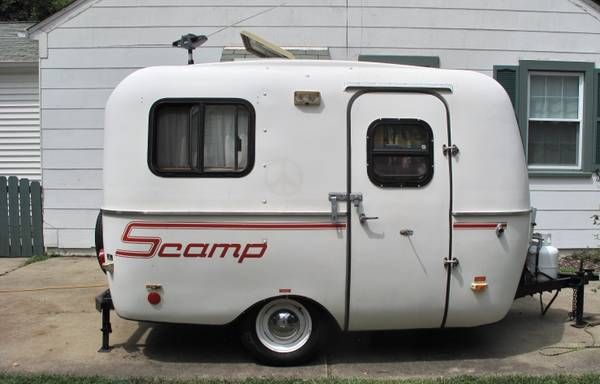 A real Scamp......
A real Scamp......![]()
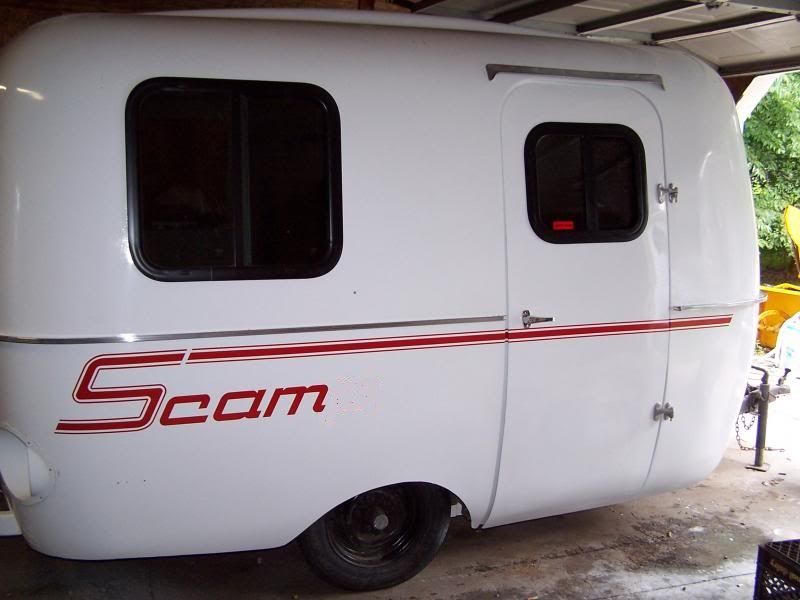 A fujioko Scam(p)
A fujioko Scam(p)![]()
in reply to aussiesmg:
I'm still trying to replicate that picture....it may be a while before I find a reasonably priced Clifford.
Just came across this show about old RVs.
http://www.gactv.com/gac/shows_hrlgd/0,3562,GAC_46045,00.html
Is funny I was just looking at a 1956 Spartan Manor on craigslist that is just an aluminum outer shell. Its to much of an undertaking for me right now but I have been reading up on vintage travel trailers for the past couple of days.
Wow, these things are actually hard to find in the winter. Seem kind'a pricy too.
I'll just leave these here....
http://columbus.craigslist.org/rvs/4828093476.html
http://dayton.craigslist.org/rvs/4809393691.html
http://toledo.craigslist.org/rvs/4826816571.html
http://minneapolis.craigslist.org/ram/for/4812921337.html
aussiesmg wrote: In reply to fujioko: ClifFord is for sale
Where is this mystical truck for sale at! Hopefully it is at least 1000 miles away from San Diego.
Its been a while since the last update, I reckon it's about time to share some project highlights. The camper still hasn't moved an inch since it was parked in the back of the garage but it gets a lot of use.
Whelp, time has come to get the camper ready for its first real camping trip. The selected campground is privately owned and is off the grid...yaaay ![]() . Anyway, I have a plan....
. Anyway, I have a plan....
 Burning the midnight oil getting the camper ready for a dry camping trip.
Burning the midnight oil getting the camper ready for a dry camping trip.
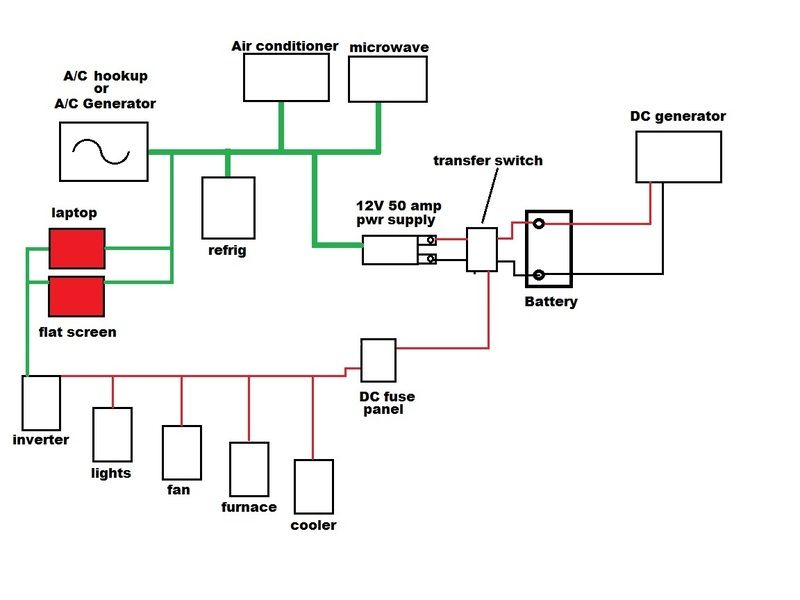 The camper is currently wired for shore power. I could just haul my 4000W generator to the campsite, however plan B is to wire the camper for DC electrical and use a custom hybrid 12V generator. I'll get into the details of custom generator soon, but for now I'll focus on some little stuff.
The camper is currently wired for shore power. I could just haul my 4000W generator to the campsite, however plan B is to wire the camper for DC electrical and use a custom hybrid 12V generator. I'll get into the details of custom generator soon, but for now I'll focus on some little stuff.
The 12V generator will not be able to supply enough juice for anything wired in green... so I will have to suffer a bit. The air-conditioning plus a bunch of other stuff will be dead weight. The schematic shows a 12V 50 amp power supply so I can power all the DC stuff when the camper is plugged into shore power. A transfer switch keeps the battery isolated while plugged into the grid.
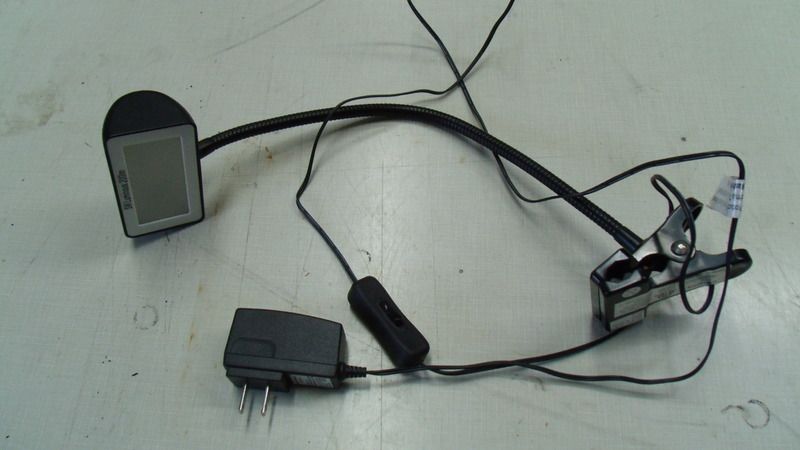 Here is a cool LED lamp I got at a garage sale for less than a buck. Unfortunately the lamp runs on A/C power...
Here is a cool LED lamp I got at a garage sale for less than a buck. Unfortunately the lamp runs on A/C power...![]() The good news is the lamp can be converted to run on DC relatively easy.
The good news is the lamp can be converted to run on DC relatively easy.
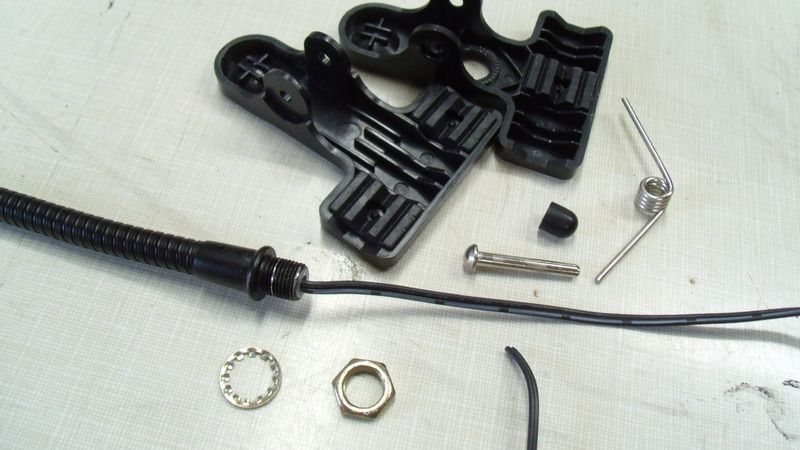 The clip on thingy has got to go. I'll fabricate a mounting base and switch to permanently mount the light to the dinette table.
The clip on thingy has got to go. I'll fabricate a mounting base and switch to permanently mount the light to the dinette table.
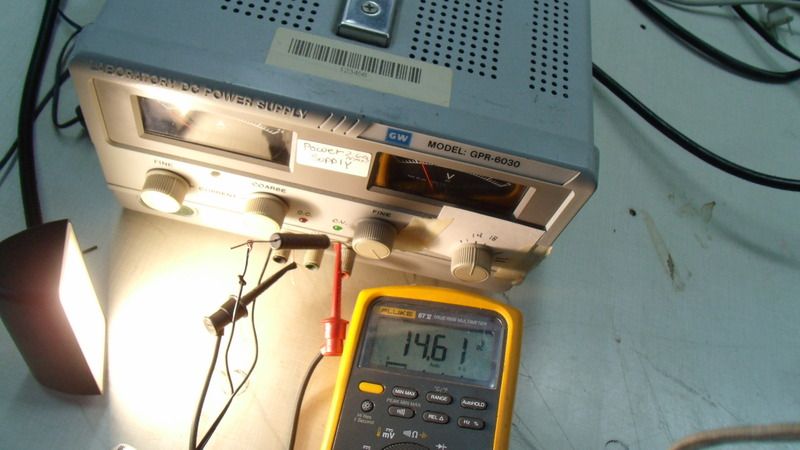 A quick test with a power supply confirms the lamp will work at 12-14 volts with a 30 Ohm 10 Watt resistor
A quick test with a power supply confirms the lamp will work at 12-14 volts with a 30 Ohm 10 Watt resistor
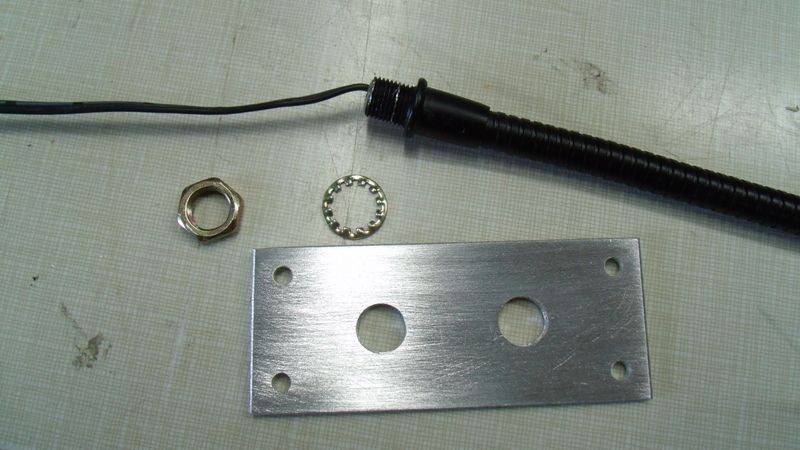 Next a new mounting plate in fabricated.
Next a new mounting plate in fabricated.
 Lamp and switch are mounted (right). A DC power port here seems like a good idea... so that's what I did.
Lamp and switch are mounted (right). A DC power port here seems like a good idea... so that's what I did.
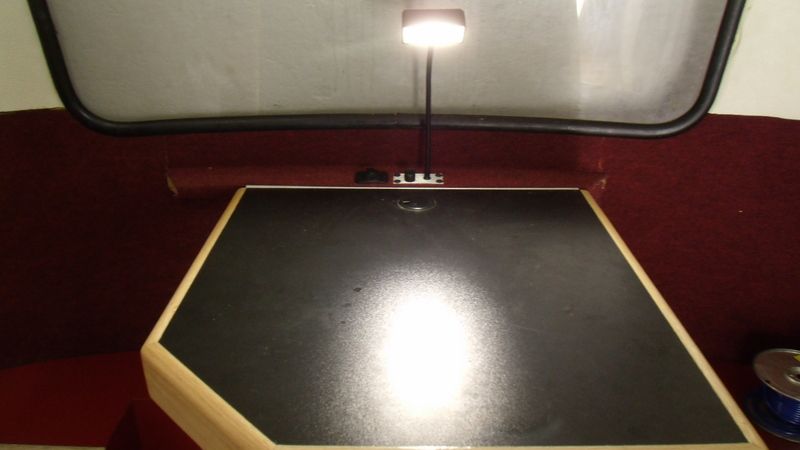 Tada!
Tada!
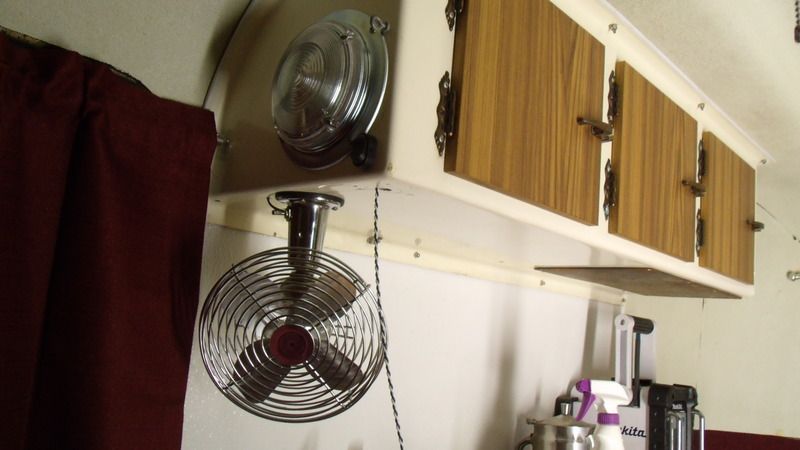 A 12V fan and another LED light were added in the sleeping area.
A 12V fan and another LED light were added in the sleeping area.
Lots more to come!
Thanks chiodos!
Better than nothing.....
My little rolling condo is better than a tent by a fairly wide margin. Obviously there are other options. A larger camper would be ideal for a person who doesn't like to camp and a diesel motor home is the ultimate in luxury. I'm a simple person and this whole camping thing needs to be cheap in many ways but also limit suffering to a degree I can tolerate. ... so better than nothing is my #1 goal.
The sink situation is somewhat debatable in the sense that a full size sink would be ideal ...on the other hand a large sink would occupy too much space. What to do....
A really small sink was located at a local RV dealer. This sink is better than nothing but isn't big enough to do anything practical ... perfect!
let's take a look...
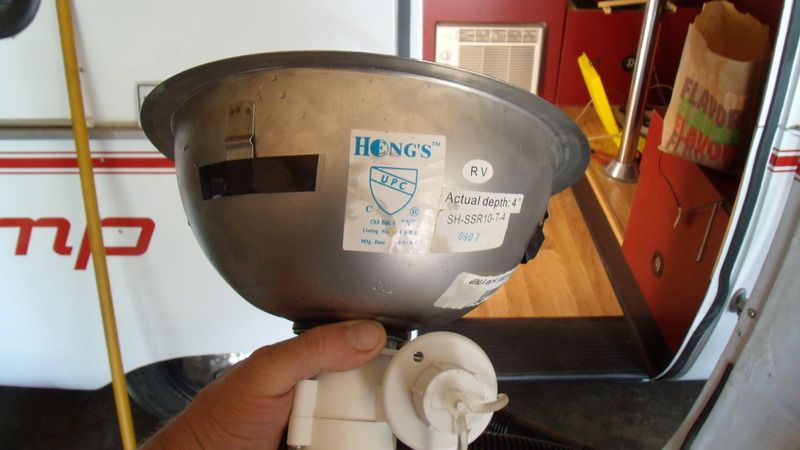 $35.00 sink is nothing more than a large soup bowl with a drain. Good for nothing more than washing hands and brushing teeth. Paper plates ain't got to be cleaned so we'll go with this.
$35.00 sink is nothing more than a large soup bowl with a drain. Good for nothing more than washing hands and brushing teeth. Paper plates ain't got to be cleaned so we'll go with this.
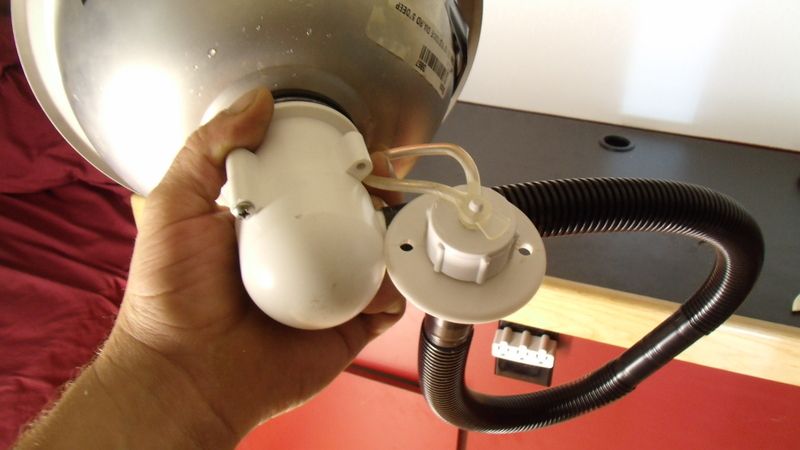 The drain option is controversial depending on camping etiquette. I hear the proper thing to do is to collect the gray water and dispose of it... or something like that. environmentally speaking the gray water is on par with the stuff I use to wash the car in the driveway. ....so the drain will pretty much dump out the side of the camper hillbilly style. In extreme situations the gray water could be collected in an external holding tank.
The drain option is controversial depending on camping etiquette. I hear the proper thing to do is to collect the gray water and dispose of it... or something like that. environmentally speaking the gray water is on par with the stuff I use to wash the car in the driveway. ....so the drain will pretty much dump out the side of the camper hillbilly style. In extreme situations the gray water could be collected in an external holding tank.

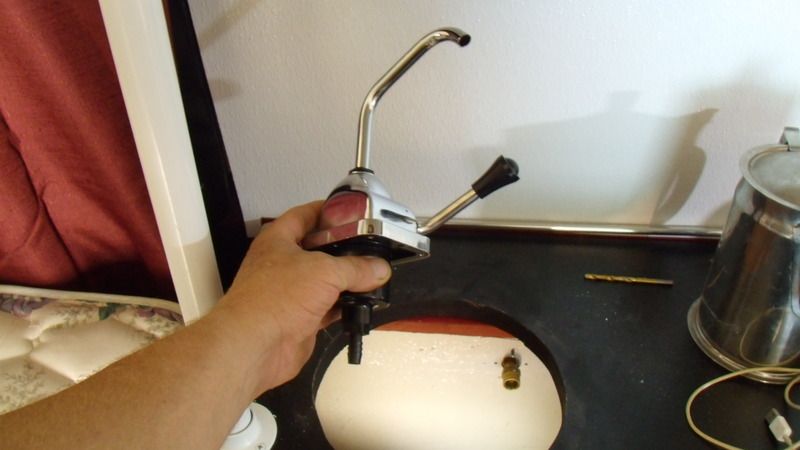 The faucet is as simple as it gets. pump the handle and you get water... or coolaid.. the point is, whatever is in the holding tank is what's on tap. I elected not go with a powered pressurized system because simplicity is goal number 2.
The faucet is as simple as it gets. pump the handle and you get water... or coolaid.. the point is, whatever is in the holding tank is what's on tap. I elected not go with a powered pressurized system because simplicity is goal number 2.
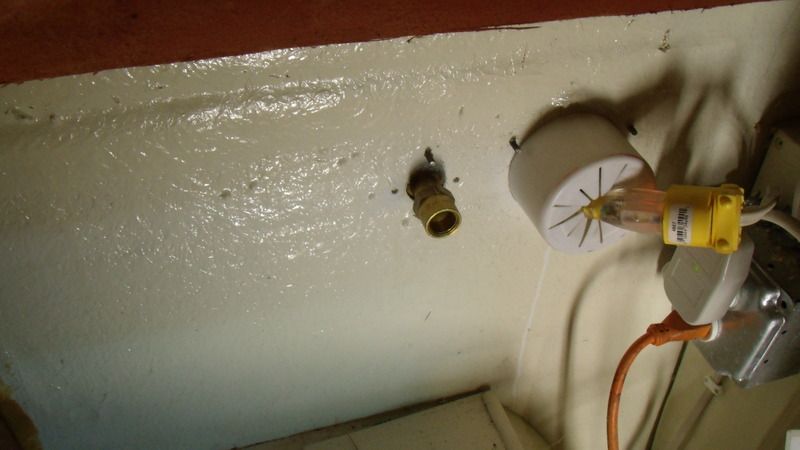 The drain will punch through the cabin using the hole currently occupied by the unused fresh water connection. A short run of garden hose outside the camper will keep the gray water from soiling the paint.
The drain will punch through the cabin using the hole currently occupied by the unused fresh water connection. A short run of garden hose outside the camper will keep the gray water from soiling the paint.
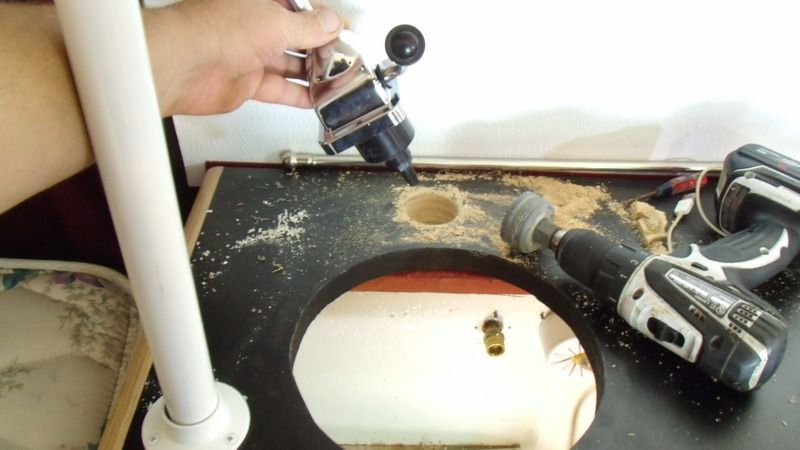 Drilling moar holes in custom counter-top is necessary...
Drilling moar holes in custom counter-top is necessary...
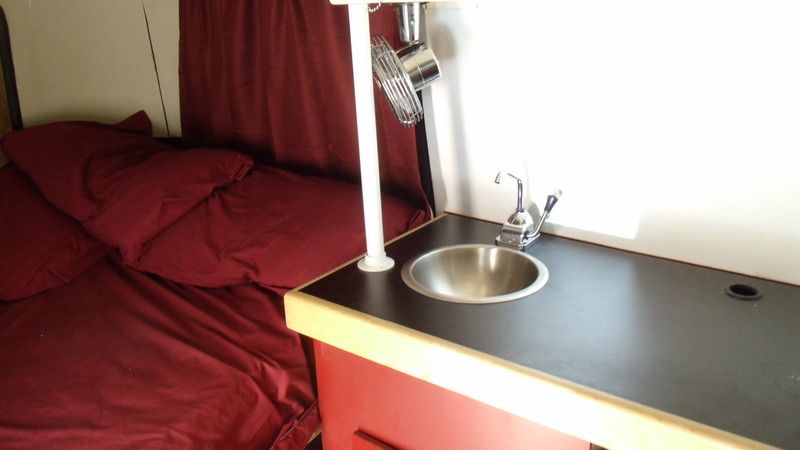 Better than nothing....
Better than nothing....![]()
POWAR!!!
This is going to get somewhat convoluted, but the end result is cheap power.
My 4000 watt backup generator has enough juice to run everything in the camper plus more. This is the ideal power source for a short term camping but it's somewhat noisy and uses more fuel than necessary.
Solar cells and batteries would work as supplemental power, but I want juice on demand if suffering is to be avoided.
Inverter generators are becoming popular with the camping crowd because they are quiet and fuel efficient. Bingo!.... except I ain't paying for one.
So lets do something different....
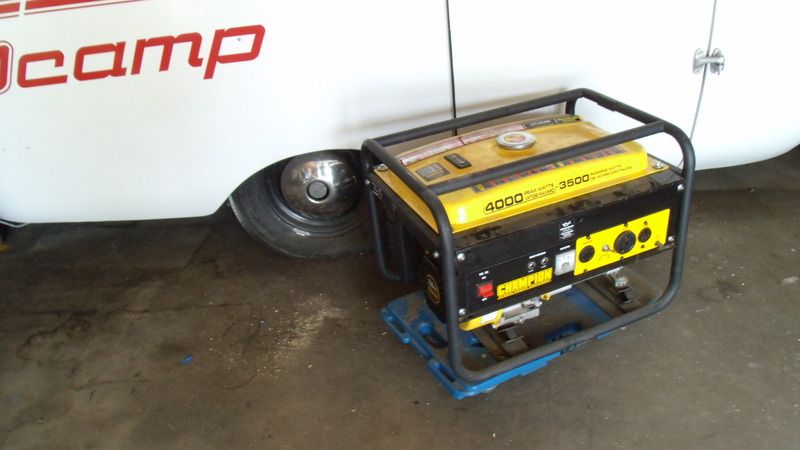 4000 watts on demand powar is the way to go! Unfortunately I'm too cheap to run something like that for more than a few hours. Nope, I need to build something because... well... GRM.
4000 watts on demand powar is the way to go! Unfortunately I'm too cheap to run something like that for more than a few hours. Nope, I need to build something because... well... GRM.![]()
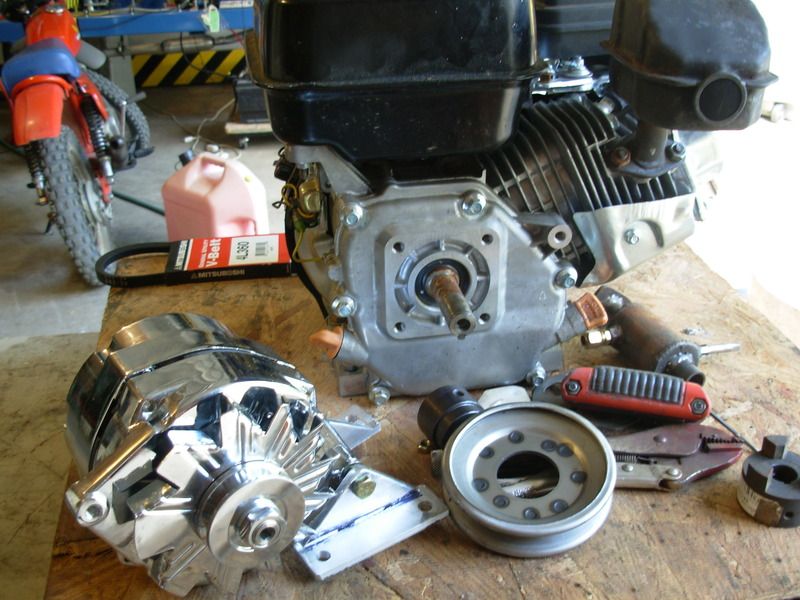 Rooting through the garage and shed plus a trip to tractor supply yielded enough junk to build the 12V generator. The engine is a Harbor Freight 6.5 HP unit that I picked up a few years ago. It was more or less collecting dust so I proclaim it to be free. The alternator is a goofy Chinese built copy of a GM integral. It is of the one wire variety... simple to connect but not ideal. Once again free is the word of the day.
Rooting through the garage and shed plus a trip to tractor supply yielded enough junk to build the 12V generator. The engine is a Harbor Freight 6.5 HP unit that I picked up a few years ago. It was more or less collecting dust so I proclaim it to be free. The alternator is a goofy Chinese built copy of a GM integral. It is of the one wire variety... simple to connect but not ideal. Once again free is the word of the day.
The belt and pulley required $$ but I'm certain I could dig through the shed a bit longer and yield something that would have worked.
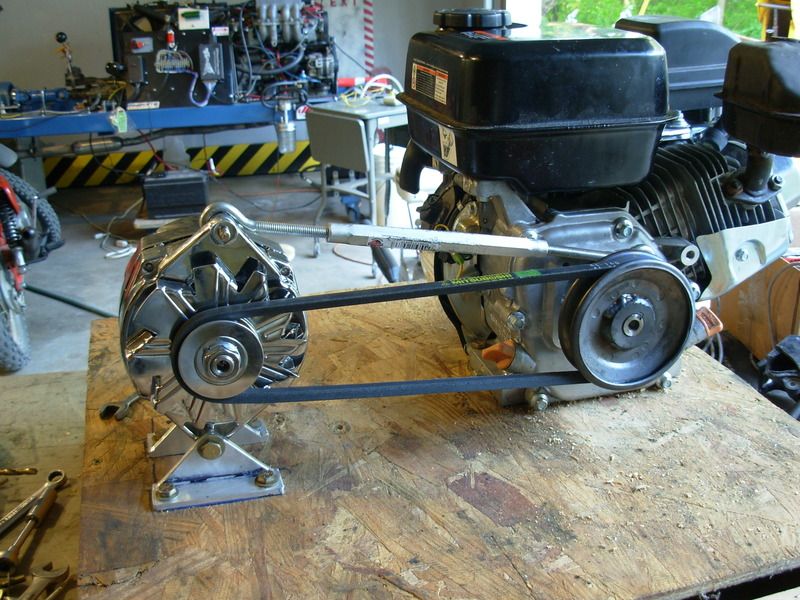 The alternator brackets were fabricated from aluminum scrap and the adjustment turnbuckle was left over from the Model T tire changing escapade. Free and free-ish.
The alternator brackets were fabricated from aluminum scrap and the adjustment turnbuckle was left over from the Model T tire changing escapade. Free and free-ish.
 this is a really crude generator inverter setup being tested. The inverter is a 1200W pure sine wave unit. It was free. Long story short, this setup will work, but the inverter is too big. After an extensive survey of other options it was determined that the inverter only needs to be large enough to power the laptop and the flat screen.... everything else will run off 12V.
this is a really crude generator inverter setup being tested. The inverter is a 1200W pure sine wave unit. It was free. Long story short, this setup will work, but the inverter is too big. After an extensive survey of other options it was determined that the inverter only needs to be large enough to power the laptop and the flat screen.... everything else will run off 12V.
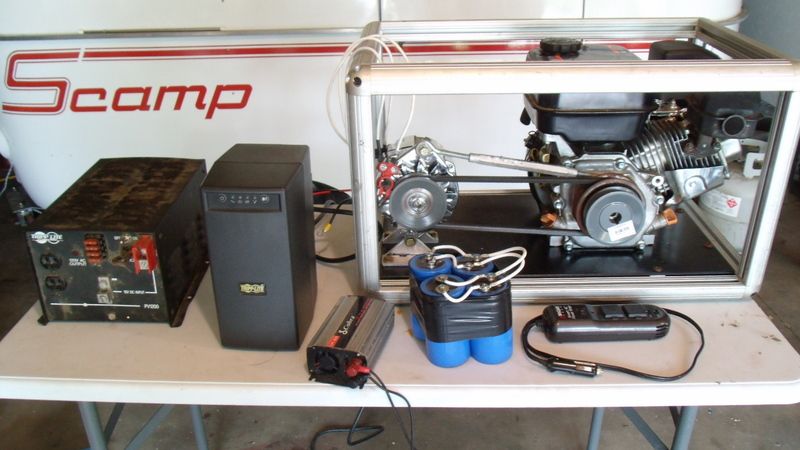 Ok, the generator evolved into a more user friendly package, but is still unfinished. Assorted inverters have been tested and the smallest one is probably the winner.
Ok, the generator evolved into a more user friendly package, but is still unfinished. Assorted inverters have been tested and the smallest one is probably the winner.
To further complicate things I experiment with eliminating the battery and used a pack of large capacitors. This actually works, but the capacitors need a jolt of voltage to get the whole system powered up. I'll get into more details as the system evolves further.
This generator is just begging for a set of CVT clutches and/or a turbo for the full GRM uber-camping experience ![]()
LOL..I agree, this generator needs moar turbo, CVT and perhaps nitrous. Ironically, in the bizarro world I live in, this generator already produces more power than my neighbors '27 Model T....
For now the 6.5 HP engine has enough grunt to charge up a dead battery and then idle down to a lazy speed to maintain the charge. Last weekend I ran the engine for well over eight hours on a single tank of fuel. According to the Harbor Freight spec sheet the tank in 0.9 gal. The load was relatively light because power usage was optimized by using the native 12V instead of running everything through the 120VAC inverter. The LED lighting, fan and thermoelectric cooler only draw 5-6 amps.
Once I button up some loose ends, I'll see how long the generator will run with the full projected load.
Making progress on the electrical system.... probably more complicated than necessary but that is how I roll.
 Here is the the transfer switch with the AC to DC power supply and DC fuse assembly. This assembly will supply all the 12 volt accessory's with power when the camper is plunged into the grid. Flipping the transfer switch will disconnect the AC/DC power supply and connect the battery to the load.
Here is the the transfer switch with the AC to DC power supply and DC fuse assembly. This assembly will supply all the 12 volt accessory's with power when the camper is plunged into the grid. Flipping the transfer switch will disconnect the AC/DC power supply and connect the battery to the load.
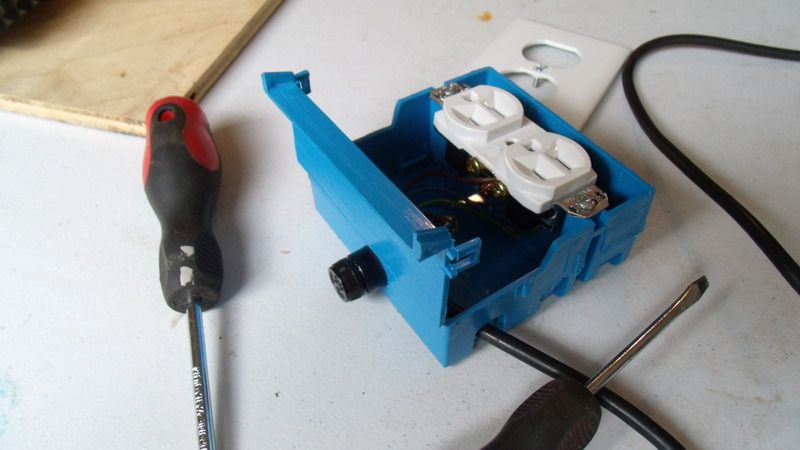 So now it gets a little tricky.... The AC to DC power supply should really have a fuse on the AC side so I put together an outlet with a fuse.
So now it gets a little tricky.... The AC to DC power supply should really have a fuse on the AC side so I put together an outlet with a fuse.
 Outlet mounted.... but wait, I need to make this more complicated..
Outlet mounted.... but wait, I need to make this more complicated..![]()
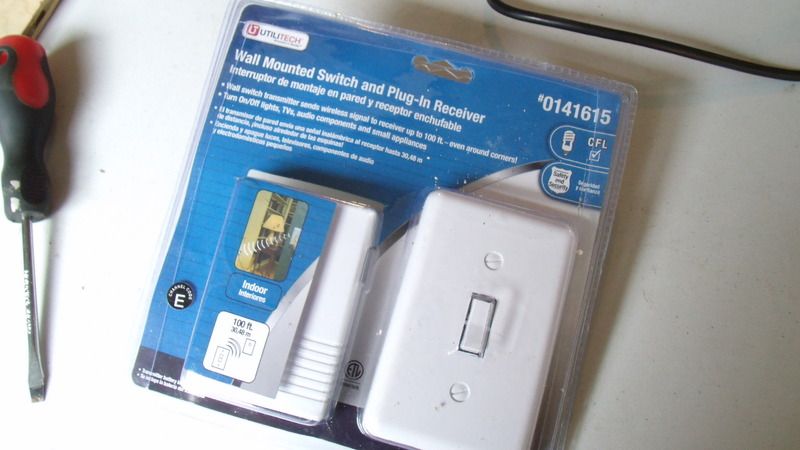 I picked up a remote outlet switch for $14.00. This will allow me to remotely turn on/off the DC power supply...
I picked up a remote outlet switch for $14.00. This will allow me to remotely turn on/off the DC power supply...
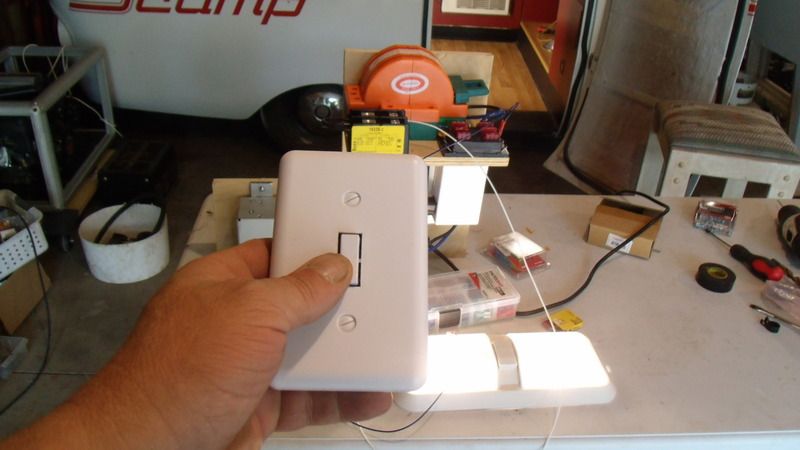 A quick test to confirm that the remote will turn the power supply on off. This is sort of trivial, but I don't want the power supply running 24/7 when the camper is plugged into the grid.
A quick test to confirm that the remote will turn the power supply on off. This is sort of trivial, but I don't want the power supply running 24/7 when the camper is plugged into the grid.
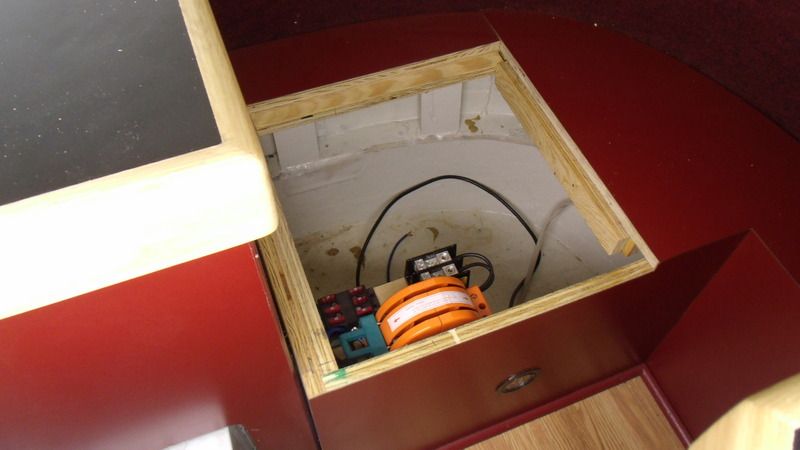 Transfer switch, power supply,fuse and remote thingy drops into the left storage bay. I hate using this space for this electrical junk but space is limited and this was the best place.
Transfer switch, power supply,fuse and remote thingy drops into the left storage bay. I hate using this space for this electrical junk but space is limited and this was the best place.
java230 wrote: The gen set looks a bit overcomplicated.....
The 6.5 HP 12 Volt generator has a lot of moving parts and will eventually be replaced with a simpler 8.4 Megawatt fusion reactor.
fujioko wrote:java230 wrote: The gen set looks a bit overcomplicated.....The 6.5 HP 12 Volt generator has a lot of moving parts and will eventually be replaced with a simpler 8.4 Megawatt fusion reactor.
Ill be waiting patiently to see that ![]()
In reply to java230:
LoL, The fusion reactor project is on hold until I can locate enough dilithium crystals![]()
Flux Capacitor....
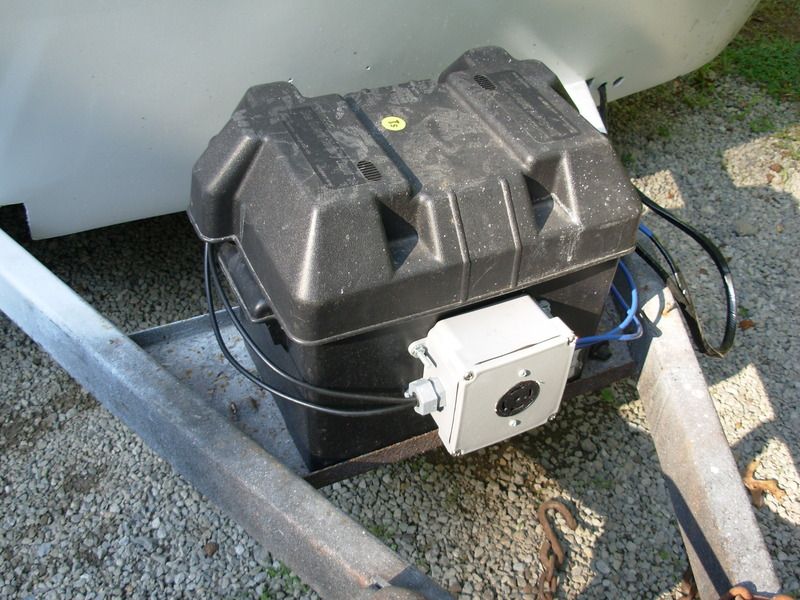 Scored a battery box at a garage sale for a dollar....wait, what that thing in front of it? hmmm... let's take a closer look.
Scored a battery box at a garage sale for a dollar....wait, what that thing in front of it? hmmm... let's take a closer look.
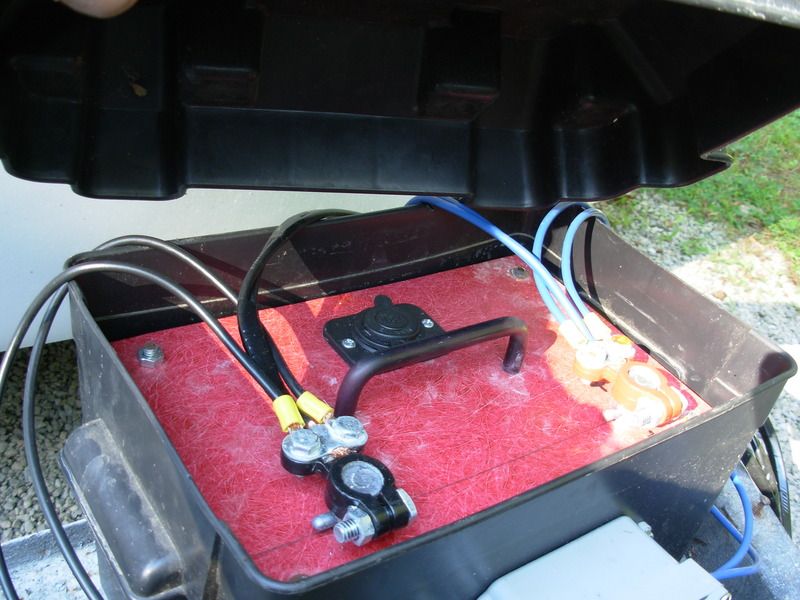 Why that's a strange look'n battery...
Why that's a strange look'n battery...
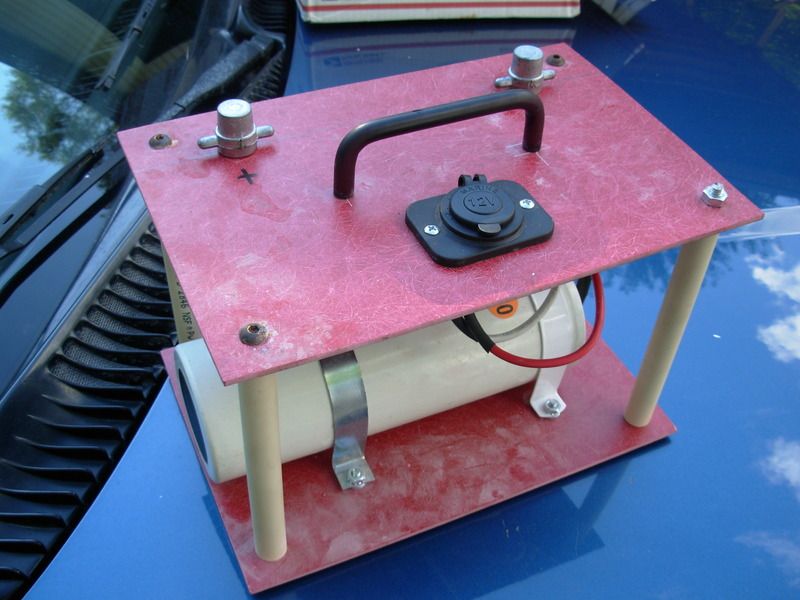 What the berkeley...Oh, its not a battery... its a ?
What the berkeley...Oh, its not a battery... its a ?
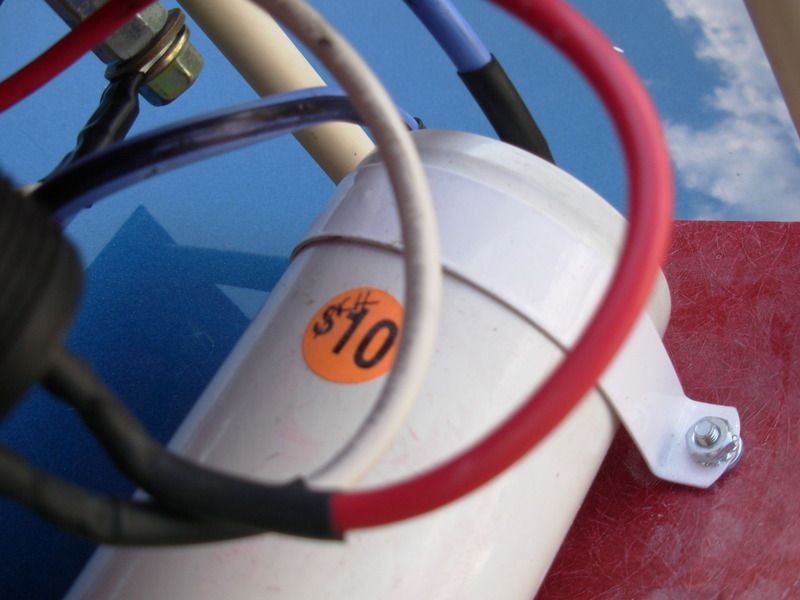 $10.00 super capacitor from a car stereo system...
$10.00 super capacitor from a car stereo system...
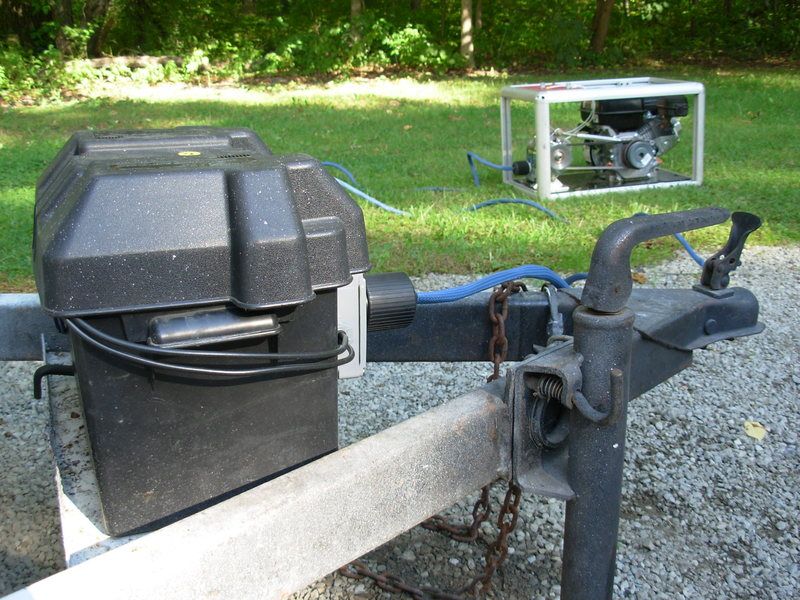 So..here's what is going on. Instead of using a battery, I rigged up a super capacitor to act like a battery. The capacitor will hold enough juice to power the camper for approximately three seconds. Which coincidentally is about how long a camping trip should be.
So..here's what is going on. Instead of using a battery, I rigged up a super capacitor to act like a battery. The capacitor will hold enough juice to power the camper for approximately three seconds. Which coincidentally is about how long a camping trip should be.
Actually the capacitor isn't really practical unless the generator is running. Once the 12V generator is fired up the capacitor will maintain the proper voltage level to operate six LED lamps, a cooling fan, a computer, flat screen TV and a thermometric cooler. Run time has been confirmed at a little under nine hours on a single gallon of gasoline.
The reason for eliminating the battery is simple economics with a twist. A real battery has a limited lifespan and needs to be replaced after a few years. The flux capacitor battery has almost an unlimited lifespan and can sit unused for many years. Fire up the generator and the capacitor comes back to life.
The single wire GM type alternator has a magnetic iron core on a critical part that self excites the alternator. In other words the alternator will generate electricity just by spinning the input... no pre-charge is necessary.
The flux capacitor is connected to the generator with a custom made quick connect cord for easy setup. Overall this system works great...so far.
More to come!
That generator about the coolest thing I've ever seen and I want to build one. I don't even know what I need it for.
You'll need to log in to post.